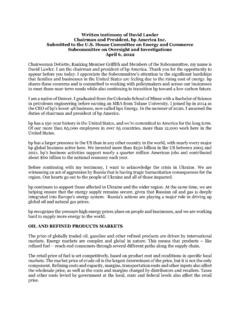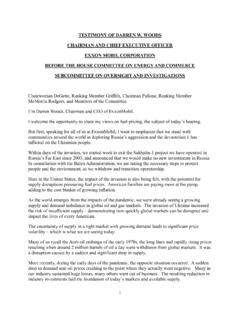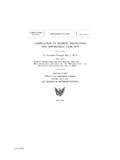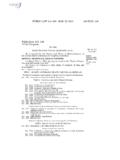Transcription of Review of the 340B Drug Pricing Program
1 Review of the 340B. drug Pricing Program Table of Contents I. Executive 2. II. Table of Acronyms .. 6. III. Findings .. 7. IV. Background .. 9. A. Overview of the 340B Program 's Development and Growth .. 9. B. Types of Covered Entities .. 13. C. Background on the Committee's 15. D. GAO and HHS OIG Reports on the 340B Program .. 18. V. HRSA Administration and Oversight of the 340B Program .. 20. A. HRSA's Implementation of 340B 20. B. HRSA's Authority to Clarify Program Requirements .. 25. C. HRSA's Audits of Covered Entities .. 30. i. Audit Findings .. 35. ii. Duplicate Discounts .. 36. iii. Diversion .. 38. iv. Incorrect Reporting .. 40. v. GPO Prohibition and Program Termination .. 40. D. HRSA's Audits of Manufacturers .. 42. E. Program Growth and HRSA's Ability to Keep Up .. 43.
2 VI. Covered Entity Use of the 340B Program .. 48. A. Congressional Intent of the 340B Program .. 48. B. 340B Program Savings .. 51. i. Restrictions on the Use of Program Savings by Covered Entities .. 51. ii. Calculation and Tracking of 340B Savings .. 53. iii. Requirements for HRSA Grantees .. 56. C. Charity Care Provided by Covered Entities .. 57. D. Medicare Part B and the 340B Program .. 65. E. Consolidation of Oncology Clinics .. 66. F. Disproportionate Share Hospital Metric and Covered Entity Eligibility .. 70. VII. Conclusion .. 75. VIII. Recommendations .. 76. IX. Appendix .. 78. 1. I. Executive Summary The 340B drug Pricing Program (340B Program ) was established by Congress in 1992, and mandates that, to remain eligible for participation in the Medicaid Program , drug manufacturers must provide outpatient drugs to eligible health care providers also known as covered entities at reduced prices.
3 Covered entities include certain nonprofit organizations such as qualifying hospitals and federal grantees identified in the Public Health Services Act (PHSA). The Health Resources and Services Administration (HRSA) is the Operating Division within the Department of Health and Human Services (HHS) that administers and oversees the 340B Program . The 340B Program is an important Program that enjoys strong bipartisan support in Congress. The Program helps reduce the prices of covered drugs for certain participating entities who, in turn, provide care for patients. Numerous covered entities have stated the 340B Program has helped ensure that underserved and indigent patients have access to affordable medicines and health care. On numerous occasions, including during the Energy and Commerce Committee's (the committee's) most recent hearing in October 2017, the committee has emphasized the importance of the 340B Program in providing care to vulnerable Over the past 25 years, the nation's health care system has changed in some significant ways.
4 For example, in 1992, there were roughly 29 million people enrolled in Medicaid and the Program spent $120 billion that year. Comparatively, in 2016, there were more than 72 million people enrolled in Medicaid and the Program cost more than $575 In that same period, the 340B Program has also grown substantially not only in the number of covered entities and contract pharmacies, but also in the amount of money saved by covered entities. HRSA. estimates that covered entities saved approximately $6 billion on approximately $12 billion in discounted purchases in Calendar Year (CY) 2015 by participating in the 340B It is estimated that discounted drug purchases made by covered entities under the 340B Program totaled more than $16 billion in 2016 a more than 30 percent increase in 340B Program purchases in just one The committee has been examining the operation and oversight of the 340B Program over the past two years.
5 Through stakeholder meetings, hearings, and document requests, the committee has identified several weaknesses in Program administration and oversight. 1. Examining How Covered Entities Utilize the 340B drug Pricing Program : Hearing Before the Subcomm. on Oversight and Investigations of the H. Comm. on Energy and Commerce, 115th Cong., Preliminary Transcript, at 84 (Oct. 11, 2017). 2. Medicaid and CHIP Payment and Access Commission, MACS tats: Medicaid and CHIP Data Book, Exhibit 10. (Dec. 2017), available at 3. 340B drug Pricing Program Ceiling Price and Manufacturer Civil Monetary Penalties Regulation, 82 Fed. Reg. 1210, 1227 (Jan. 5, 2017). 4. Aaron Vandervelde and Eleanor Blalock, Measuring the Relative Size of the 340B Program : 2012-2017, BERKELEY RESEARCH GROUP (July 2017), available at 2.
6 Congress did not clearly identify the intent of the Program and did not identify clear parameters, leaving the statute silent on many important Program requirements. According to the 1992 House Report accompanying the legislation, the 340B Program was intended to enable [covered] entities to stretch scarce Federal resources as far as possible, reaching more eligible patients and providing more comprehensive services. 5 It is unclear whether Congress intended low-income and uninsured individuals to directly benefit from the reduced drug prices offered under the 340B Program . Congress should clarify the intent of the 340B Program and, in doing so, evaluate how developments in the health care landscape over the past 25 years have affected, if at all, the structure and goals of the 340B Program .
7 HRSA lacks sufficient regulatory authority to adequately oversee the Program and clarify Program requirements. In 2014, a federal court ruled that HRSA's regulatory authority is limited to three specific areas, including (1) establishing and implementing a binding Administrative Dispute Resolution (ADR) process for the resolution of certain disputes relating to compliance with 340B Program requirements, (2) providing for the imposition of civil monetary penalties (CMPs) against manufacturers that knowingly and intentionally overcharge a covered entity for a 340B drug , and (3) issuing precisely defined standards of methodology for calculation of 340B. ceiling prices. As a result, HRSA is unable to issue rules that would clarify certain Program requirements. In addition, HRSA has not fully implemented guidance or regulations in the three areas where the agency has regulatory authority, nor has HRSA issued guidance on fundamental aspects of the Program such as the definition of an eligible patient.
8 Consequently, important aspects of the Program have remained vague, as the statute is silent on many key aspects of the Program , resulting in variation in the way covered entities use the Program . HRSA should finalize regulations in the areas in which it has regulatory authority, and Congress should provide HRSA with more regulatory authority to adequately administer and oversee the 340B Program , including the ability to improve Program integrity, clarify Program requirements, monitor and track Program use, and ensure that low-income and uninsured patients directly benefit from the 340B Program . HRSA's primary compliance mechanism is the agency's annual audit process. HRSA. began auditing covered entities in 2012. HRSA conducted 51, 94, and 99 audits in the first three years of auditing, and since 2015 has conducted approximately 200 audits annually.
9 HRSA's annual audits uncovered a high level of non-compliance by covered entities. Given HRSA's limited authority, HRSA only conducts a limited Review of the covered entity's use of the Program during the audit process. Specifically, HRSA audits entities only for Program eligibility, duplicate discounts, diversion to ineligible patients and facilities, and incorrect database reporting. HRSA also conducts audits of manufacturers to determine whether they are offering drugs at prices no higher than the 340B ceiling price. The Patient Protection and Affordable Care Act (PPACA) dramatically increased the size and scope of this Program by expanding eligibility to more types of hospitals, such as critical access hospitals and sole community hospitals, and expanded Medicaid eligibility. Program participation has more than quadrupled over the past decade.
10 While HRSA's authorities and resources have increased over the same period, they do not appear sufficient to meet the demands of this Program . Although HRSA has increased the number of covered entity audits it conducts 5. Rep. 102-384, Pt. 2 (1992). 3. per year, the percentage of covered entities audited in 2016 was below two percent of total entities participating in the Program . Program growth has outpaced HRSA's ability to effectively oversee the Program . Congress should equip HRSA with the resources and staff necessary to conduct more rigorous oversight of the Program . In addition, Congress should consider whether the permissible scope of HRSA's audits should be expanded, and HRSA. should work toward auditing covered entities and manufacturers at approximately the same rate. To further aid HRSA in its administration of the Program , Congress should require certain covered entities to conduct independent audits of Program compliance, including of any contract pharmacies.



![[DISCUSSION DRAFT] TH D CONGRESS SESSION H. R. ll](/cache/preview/4/0/a/d/4/2/1/d/thumb-40ad421dbafdce194f0ad7b8bca5f144.jpg)






